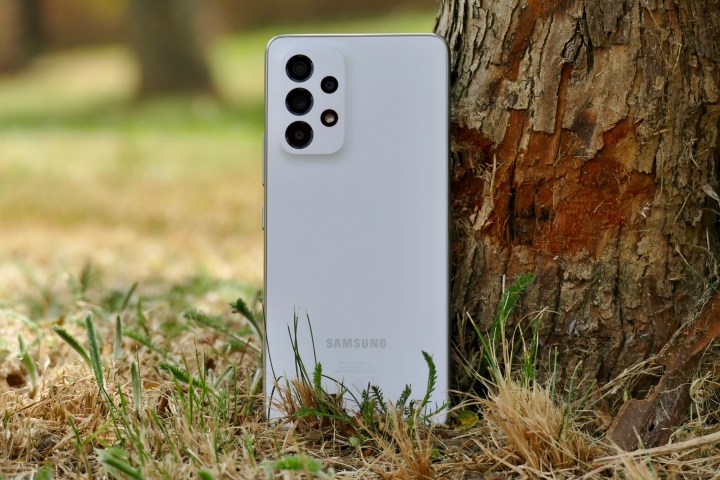
“While it's not a massive upgrade to its predecessor, the Galaxy A53 5G is capable and pretty, comes with Samsung's assurance of quality, and is available at a reasonable price.”
- Pretty design
- IP67 water-resistance
- Camera is great for social media
- Vibrant screen
- Two-day battery life
- Performance can be sluggish
- Not an upgrade to the A52 and A52S
The Samsung Galaxy A53 5G isn’t really all that different from the A52 and A51 that came before it, with Samsung clearly feeling it didn’t need to dramatically overhaul an already established (and very well received) formula. But was it the right decision, or has it resulted in stagnation for the popular A-Series mid-range device?
It’s most definitely the former. Samsung has not only upgraded where necessary, but it also knocked $50 off the old price and left the phone alone in the places that matter. Well, mostly, at least. Let’s see if Samsung’s $449 Galaxy A53 5G is still one to buy.
Design
There’s almost nothing to separate the Galaxy A53 5G from the Galaxy A52 5G in terms of design. For me, the déjù vu was jarring and immediate because I was sent a white version for review, just like I was with the Galaxy A52 5G. There are some tiny differences in size — it’s 8.1mm thick, not 8.4mm thick like the A52 5G — but the weight remains the same at 189 grams. It’s made of plastic with Gorilla Glass 5 over the screen, just like the A52 and Galaxy A52S.

So, Samsung’s design department has been pretty lazy, right? Perhaps, but I’m not going to hold it against them because the Galaxy A53 looks excellent. The back may be made of plastic but it has a wonderful warm feel and a pleasing texture that provides plenty of grip. The white finish doesn’t show fingerprints or smudges unless you really look hard, and the swooping, integrated camera module is stylish and doesn’t protrude much.
Samsung has removed the 3.5mm headphone jack though, which doesn’t bother me personally but may frustrate others. An IP67 water-resistance rating gives peace of mind and isn’t common on phones at this price. The Galaxy A53 is quite a chunky thing, and I find one-handed use a challenge, which isn’t helped by the fingerprint sensor being set quite low on the screen.
However, I’ll take the iffy ergonomics here, as Samsung has fixed everything that was terrible about it on the Galaxy A52. It’s not quite as fast as the very best fingerprint sensors available on phones like the OnePlus 10 Pro, but it is reliable, and that’s what really matters. It hasn’t failed to read my thumbprint once, and although it takes a beat longer than I expect, the fact it has unlocked the phone every time makes me happy. It’s a vast improvement over the awful fingerprint sensor on the Galaxy A52.

Making the fingerprint sensor better is a huge deal, as it was really the only major downside of the Galaxy A52. Has it set the Galaxy A53 on the path to a perfect score? Not quite, as another internal change hasn’t worked out quite so well, but I’ll come back to that in a moment. Samsung was right not to change the Galaxy A53’s stylish design and durable build. It may be familiar, but it’s also excellent.
Camera
The Galaxy A53 5G has four cameras on the back: A 64-megapixel main camera with an f/1.8 aperture and optical image stabilization (OIS), a 12MP wide-angle camera with a 123-degree field of view, and a pair of 5MP cameras for macro and depth. It’s the same setup found on the Galaxy A52, and you get the same 32MP selfie camera mounted top-center in the screen, too. Features include Night mode and a Pro mode, Samsung’s Single Take mode, and video recording up to 4K and 30fps or FHD at 60fps. Plus, there are various Snapchat Lenses built into the camera, and the augmented reality effects work really well.

Not everyone is going to like Samsung’s overly saturated photos, but there’s no denying the Galaxy A53 can really make some scenes pop off the screen. If the photo has some green, blue, or red in it and it’s a sunny day, you can be sure the A53 is going to accentuate them. Realism is not the goal here. Instead, it’s giving you the perfect social media photo without the need to edit.
Overall, the A53 takes good photos. Consistency between the main and wide-angle cameras is acceptable, lowlight performance is decent without too much noise in images, and the selfie camera captures skin tones and details effectively. Don’t expect it to worry the Galaxy S22 Ultra, though, as apart from the oversaturated looks, it doesn’t like challenging lighting conditions. Overcast days or low sunlight produced poor photos. The 2x option is also a digital zoom and not an optical one, so quality drops considerably when you use it.
The photo editing suite is great and adds versatility to the camera system. The useful Object Eraser mode is present and seems to work in the same way it does on more expensive Galaxy smartphones. There’s also a Spot Color mode, and plenty of filters, too. The Galaxy A53’s camera is great for casual, fun use. It’s not going to challenge the best camera phones, but if you want to take good photos and share them online, it won’t disappoint.
Performance and screen
The Galaxy A53 has a Samsung Exynos 1280 octa-core processor inside, rather than the Qualcomm Snapdragon 750 or Snapdragon 778 from the A52 series phones. It’s available with 6GB or 8GB RAM and 128GB or 256GB storage space. The Galaxy A53 is one of the few phones to come with space for a MicroSD card slot, so don’t immediately assume you have to get the 256GB model. For reference, I’m using a UK-supplied phone with 6GB RAM and 128GB storage.

It’s here where the Galaxy A53 loses the points it gained with the improved fingerprint sensor. The phone isn’t always the speediest performer, with noticeable hesitations and sluggishness sometimes appearing throughout the software. None of them are deal-breakers, and none drastically affect the phone on a daily basis, but you will notice them. For example, starting the A53 takes a considerable amount of time. Apps take a second longer than expected to open, the camera is a little slow to take photos, and some transitions and animations aren’t all that smooth.
This may not be down to the Exynos 1280 processor entirely, as the issues tend to be worse after waking the phone up after it has been left alone for a while — suggesting some aggressive power management may be at work. None of this affects games, and once Asphalt 9: Legends was going, the hesitation disappeared and there was no evidence of harsh frame rate drops. The Galaxy A53 does get warm to the touch when you play for a while, indicating the Exynos processor is having to work pretty hard to keep up. If you’re a casual gamer, you’ll be happy with the A53, but it’s not a phone for the serious player.

All this is viewed on a 6.5-inch Super AMOLED screen with a 2400 x 1080 pixel resolution and a 120Hz refresh rate. It’s the same panel found on the Galaxy A52. In many ways, it echoes the images produced by the phone’s camera. Colors are so vibrant and bright, for example, in Kawaguchi Yurina’s music video for Cherish, they threaten to leap out of the phone there’s so much visual pop. Detail remains though, even in the city-at-night scenes in Woyshnis Media’s stunningly filmed Lamborghini Huracan vs. Audi R8 video.
Wide viewing angles, loud stereo sound, and that smooth 120Hz refresh rate make the Galaxy A53 an excellent multimedia phone, ideal for anyone who regularly watches video or listens to music but only has a passing interest in games.
Software and battery
My review Galaxy A53 has Android 12 with Samsung’s One UI 4.1 installed, along with Google’s May 1 security patch. It’s the same software you’ll find on the Galaxy S22, the Galaxy S22 Ultra, and even the Galaxy Z Fold 3. Samsung promises four years of software updates and five years of security updates, which is the best long-term support you’ll get on any phone outside of Google’s Pixel series or an Apple iPhone. It’s especially welcome on a phone that doesn’t cost $1,000 or more.

Samsung’s One UI suits most of my personal preferences for software on a smartphone. It’s sensibly designed and retains a lot of what makes Android 12 attractive, Google Discover is a swipe away from the Home screen, and there are plenty of customizations. Because the default settings are reasonable, you aren’t immediately forced to change much. The always-on screen is informative, notifications are reliable and interactive, and Google Pay is available if you don’t want to use Samsung Wallet.
Samsung Wallet is a good example of where One UI may irritate. Samsung installs many of its own apps for various different services — a variety of likely unwanted third-party apps — plus it has an intrusive recommendation system for more apps it wants you to install. Samsung’s keyboard isn’t as natural to use as Google’s Gboard, but it’s the default option. This means you may have to do a little clean-up and change some of the standard app settings before the phone feels like your own.
The Samsung Galaxy A53 5G is a reasonably priced, reliable, pretty, and capable everyday smartphone.
The A53 has a 5,000mAh battery, which will last for two days if you’re not a hardcore gamer. Moderate use — social, browsing, messaging, some video, and the camera — hasn’t seen the battery dip below 50% after a single day for me. Add in any power-hungry gaming and the A53 starts to gobble up the battery’s energy. It’ll still last a full day and into the second, unless you’re playing for hours, but a trip to the charger at the end of day one will avoid any anxiety if you’re pushing the phone hard.
Samsung has unpacked the charging block from the Galaxy A53’s box but has kept the USB Type-C cable. The phone supports 25W fast charging, which uses Qualcomm’s Power Delivery 3.0 standard. Samsung charges $35 for the official version, but cheaper PD 3.0 compatible chargers can be found from other manufacturers that will do the same job. Charging takes around 80 minutes.
Regarding connectivity, I’ve had no issues with call quality or connecting to 4G and 5G networks, and pairing Bluetooth headphones — particularly Samsung’s models — is fast with a stable connection.
Price and availability
The Samsung Galaxy A53 5G costs $450 or 399 British pounds. It can be purchased , through retailers including Amazon and Best Buy, and through most networks with a contract too. One thing to note is Verizon sells a version called the Galaxy A53 5G UW, which connects to its mmWave 5G network. It costs $500. All other carriers and the unlocked models support Sub-6 5G.
Our Take
The Samsung Galaxy A53 5G is a reasonably priced, reliable, pretty, and capable everyday smartphone, suited to anyone who isn’t going to be playing demanding games for hours each day and is mainly interested in the camera for photos to share with friends online. The Galaxy A52’s major downside, the fingerprint sensor, has been fixed for the A53, but the strife it caused has been replaced by sluggish performance in some situations.
It’s not so bothersome you’ll hate the phone, though, and I’ve used it happily as my primary device without wanting to change my SIM early. You’re getting Samsung’s overall quality, its highly livable software, and a screen built for great-looking video — all for less money than the predecessor cost. The Galaxy A53 5G is a recommended, and very sensible, purchase, but it’s slightly disappointing it doesn’t look or feel like a step forward compared to the A52 or A52S.
Is there a better alternative?
The Galaxy A53 5G has two natural alternatives, the Google Pixel 5a and the Apple iPhone SE (2022), both of which cost around the same price. The Pixel 5a will be replaced soon by the Pixel 6a, but either will provide a superior camera experience. The iPhone is more powerful but may require you to switch to iOS from Android and absorb some of the costs this involves regarding apps and services. Your choices are more plentiful in the U.K., with the OnePlus Nord 2T a strong contender as an alternative, along with the Realme GT 2.
If you can stretch to a little more money, the Pixel 6 is worth looking at with its great camera, stylish design, and clean Android software. The Galaxy S21 FE falls into the same price bracket if you want a Samsung phone, and if you’re happy to switch and adopt Apple’s iOS, so does the standard iPhone 13. All are excellent purchases with long software support and masses of ability. If you own a Galaxy A52 or have just bought a Galaxy A52S, you’re not missing out by not having the Galaxy A53.
How long will it last?
You will get at least two years of use out of the Galaxy A53 5G before it even begins to look or feel a little out of date. Samsung’s excellent software commitment means it will receive updates for another few years after this, so there won’t be any need to rush to upgrade if your usage stays the same. The phone’s plastic back and chassis mean it’s not too fragile, and the IP67 water-resistance rating ensures it is entirely protected from dust, particulates, and strong jets of water.
Should you buy it?
Yes. The Galaxy A53 5G is a good value considering its quality, ability, camera, and software.
Editors' Recommendations
- Visible’s affordable 5G plans just got even cheaper
- 5G home internet: What is it, and should you get it?
- The best Moto G Power 5G (2024) cases: 7 great choices
- The best Moto G 5G (2023) cases you can buy
- The best Samsung Galaxy Z Fold 5 deals in March 2024





















